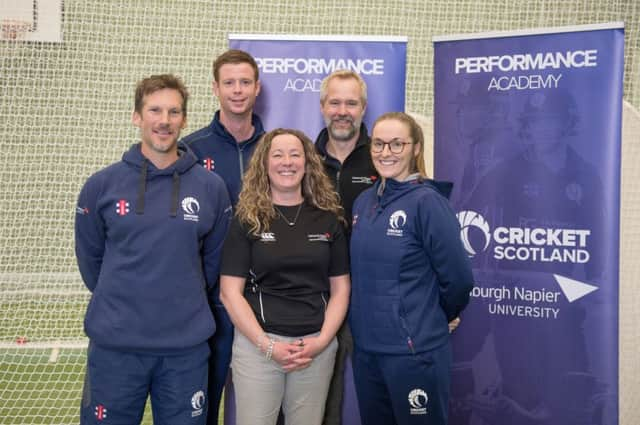New Cricket Performance Academy aims to stop talent drain to England


This one is moving slightly more smoothly. Dr Susan Brown assesses the action. “This is not quite yet what you could call an elite bowling action,” she says, suggesting there’s work to be done to improve this particular student’s delivery, which is one of the reasons for establishing a Cricket Performance Academy at Napier University’s Sighthill campus.
The venture, which was launched yesterday, is a partnership between Cricket Scotland and the university and is intended to support the development of young male and female cricketers. A new two-bay net lane has been installed at the university’s ENGAGE sports facility.
Advertisement
Hide AdAdvertisement
Hide AdAnother fascinating feature is the on-site biomechanics laboratory, which players all have access to. It’s here where we are watching a skeleton perform several medium-paced left-arm deliveries. In reality, it’s one of the students reduced to skeletal form by a three-dimensional motion capture system.
“There are 12 cameras which talk to each other and regenerate images into three dimensions, which effectively means you can visualise the image from any orientation; side, front on, from the back, from above if necessary,” explains Dr Brown, Napier University’s lead for partnership and enterprise in sport.
“It means we can see things like amount of rotation in pelvis or direction of a planted foot – it captures the images at 500 frames a second. You are not making assumptions in gaps between frames, which you would have to do with a video camera. It gives us much more details and allows us to calculate angles, such as elbow angle.”
The laboratory was initially intended to analyse golf swings. If you can capture that, you can capture anything, including a bowling action or batting stroke.
“Helping players, that’s what is it all about,” says Cricket Scotland performance coach Toby Bailey, who will be based at Sighthill, where five players are already taking advantage of the dual career policy allowing athletes enough flexibility to combine training with studies. This number is hoped to double next year. Bailey believes it is another step on the road to full member status, a long-held ambition for Scotland. Such high-profile achievements as beating England for the first time two summers ago is one large step forward, yesterday’s announcement another.
“The more high-performance systems we have, the more it is going to help us get there,” said Bailey. “Performance comes from all the work and systems you have in the background. It’s not a coincidence, performance does not just happen.”
Megan McColl is one beneficiary. A month into a sports and exercise science degree, the 19-year-old all-rounder can devote as much time to cricket as she needs. “With Cricket Scotland, Napier has joined up in a partnership to allow us developing cricketers more one-to-one time, more session and fitness time and also allows me to balance my cricket and education so I can have the back up of my degree.”
Abbi Aitken-Drummond watches on with a degree of envy. Now 28, she wishes she could have taken advantage of this set-up when she was breaking through. Still a valuable member of the women’s team, she said: “When I was 14, I was straight in from club to the national scene, and don’t get me wrong – I had some incredible experiences. But we want to make it harder for 14-year-olds to get into the Scotland team. Now we have pathways in place, including a performance academy, we want them to be part of a journey. It’s too much to ask someone of that age to go straight in.
Advertisement
Hide AdAdvertisement
Hide Ad“Developments like this at Napier give us time to find out what kind of players they are, and what people they are. There are players here that are worth investing in.”
That’s one of the problems as Scotland seek to take the next step forward – losing players or seeing development rates drop off due to lack of playing opportunity.
“In the past players, if they wanted a cricket education, might have to go to an MCC University,” says Bailey. “They go to these universities (in England) but don’t get on to a performance programme because they are not in the first team. They come back and they have actually regressed.
“We need to bridge the gap after Under-19s in order to take them to the next level.”